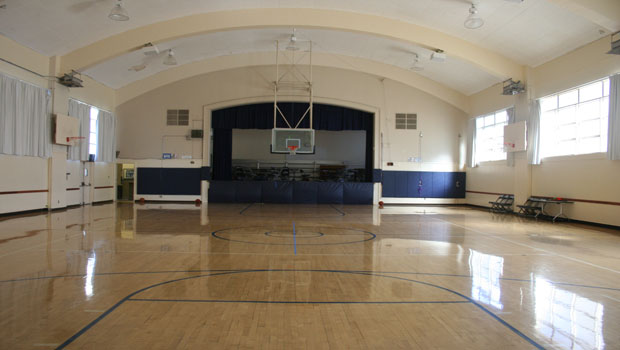As I scaled a 30-foot wall, searching desperately for tiny colored handholds to grip with my sore fingers and trying not to get caught in the ropes, I looked at my belayer way down below and laughed.
I was so glad to finally be getting exercise after a series of long lethargic weeks. Tapping at a keyboard for finger strength and agility training just wasn’t cutting it. So what better place to be than hanging high up in the air on a rope, straining to reach the top of an artificial cliff?
There was only one catch: I was barely breathing hard, and I wouldn’t return to Planet Granite for another week.
The problem with Urban’s physical activity program is that if you’re like me and you don’t play sports all year round, it’s possible to graduate after four years without breaking a sweat. You can get exercise in other ways, but if you only participate in afterschool activities, chances are you’re an exercise slacker. And it’s Urban that is to blame for our existence.
In order to graduate, an Urban student must accumulate eight athletic credits, which can be earned by playing a sport, participating in a physical activity class, or partaking in an interest outside of school, such as a dance class or city soccer team. According to Greg Angilly, Urban’s athletic director, only 61 percent of students participated in sports at Urban last year, and the rest took physical activity classes or received credit for activities outside of school.
Just what Urban students do to exercise varies from student to student. Urban has a wide variety of options in addition to rock climbing including yoga, strength and conditioning, hip hop dance, swimming, bike riding, fencing, pilates and capoeira. Unfortunately, they all take place after school, not during the day when more students could take them and benefit from them without cutting into after-school time. Not surprisingly, many students would rather do homework than laps.
Michael Shigezumi (’12) says he would like to get more exercise. He adds, “some people are just more athletic than others.”
Angilly believes that “if we present enough … physical (activity opportunities) for Urban students,” everybody can find something they’re interested in. He wants to “push students to exercise (but) give them the opportunity to exercise in a manner that’s exciting to them.” But that isn’t enough.
Jennifer Epstein, Urban’s Health Education teacher, says a healthy sweat is good for your head. Exercise is “something that makes people feel good about themselves, about their bodies, (and it) can help keep away the blues,” she says.
But she adds that it’s “not enough to just have one of those activities (per week)” and that “people need to supplement their activity on their own” if they are not participating in a sport.
Daphne Miller, a physician with a private family practice in San Francisco, says that teenagers should get “at least 45 minutes of moderate exercise” per day, which means that you are “sweating … (and) moving hard but can still speak in sentences.”
Unfortunately, save for the monumental physical exertion of my fingers on the keyboard, I do not meet this daily requirement.
The argument for exercise in high school couldn’t be stronger. According to the TeensHealth section of kidshealth.org, exercising helps keep bones strong, which is important for preventing osteoporosis as we get older. It also “decreases a person’s risk of developing certain diseases, including Type 2 diabetes and high blood pressure,” which are becoming more prevalent among teens. We slackers need to step up our exercise now so that it becomes a lifelong habit.
Unfortunately, making exercise a part of the school day isn’t easy. Charlotte Worsley, assistant head for student life, recalls when Urban conducted a curriculum review in the mid 1990s and found that Urban was not in compliance with California state law, which requires 400 minutes of physical exercise every 10 school days for pupils in grades seven through twelve. Sports classes were added to the schedule, but administrators soon found that students preferred to study during the day instead of taking the classes.
When asked about the prospects of putting P.E. into the school day, Worsley replied, “good enough is going to have to be just fine …. in terms of scheduling, it’s not going to be more than it is.”
Urban’s system is not unique. Elliot Smith, the athletic director at Lick-Wilmerding, says that freshmen are required to take a climbing wall class as part of the health curriculum, but during sophomore year, students must play a sport or do an outside activity in order to get credit as there is no P.E. class.
One positive change this year is that Urban students can earn up to one physical activity credit for participating in two outdoor trips during a term. Sarah Fontaine, the director of outdoor trips, believes that “we should be helping young people to cultivate good habits of taking care of their bodies.”
But for me, that’s not enough. I believe that Urban should require a physical education class during the school day throughout all three terms. It would be a class only for those who are not playing a sport during that trimester, and students like me should want to take it because they should want to get more exercise. A P.E. class would provide a break from the academics as well as a time during the day to move around and relieve stress.
The climb at Planet Granite was challenging, and it was satisfying to slap the top of the synthetic cliff and declare victory. But my sense of victory was short-lived. If Urban had that P.E. class, maybe I could keep the muscles I developed during my climb. Even a slacker can want to be buff.


